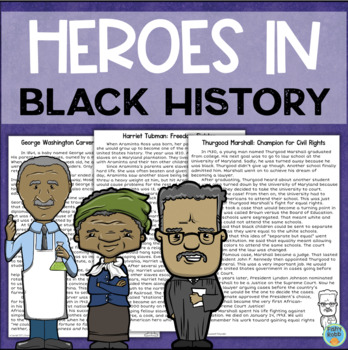
Meaningful Black History Month Activities for Elementary Students
February is Black History Month. Like many teachers, I have very little time in my day to fit in anything that doesn’t align with the required curriculum. But there is so much important history to be learned by studying the achievements of African Americans, the Civil Rights Movement, and notable black women and men all over the world – because black history isn’t limited to the United States!
In this blog post, I’m going to share some of my favorite Black History Month activities for elementary students to get you started.

How did Black History Month begin?
In 1915, American historian and scholar Dr. Carter G. Woodson established the second week of February as “Negro History Week.” This week was chosen because it coincided with the birthdays of two influential figures in African American history: Abraham Lincoln and Frederick Douglass.
Over the years, Negro History Week gained popularity and support across the country. More and more communities, schools, and colleges began observing it. Finally, in 1976, President Gerald Ford officially recognized February as Black History Month.
It has since become an annual observance dedicated to celebrating and learning about the achievements, contributions, and struggles of black Americans.
.
Black History Month Activities for Elementary Students
Since social studies has fallen victim to a focus on language arts and math, I try to integrate Black History Month lessons into my language arts block. If you look at Common Core and some other state standards, you’ll see that many of the “Speaking and Listening” standards provide the perfect opportunity to read, learn, and talk about black history. Here are some Black History Month activities for elementary students that can help meet those standards.
(Note: This post may contain affiliate links.)
Read Alouds For Black History Month
.

One of my favorite books to read aloud is My Daddy, Dr. Martin Luther King Jr. written by MLK’s own son. You can probably find it right in your school library or media center.
This book offers a new perspective to the story of Dr. King, one that many children can relate to. It’s a proud son talking about his loving father.
.
I read this book in January, since that’s when we celebrate Martin Luther King Jr.’s birthday. But, it’s a great way to kick off your study of black history.
After the book, I give students an opportunity to write about their own fathers. This allows for making text-to-self connections and integrates writing into our studies.
When Black History Month rolls around in February, I remind students about the wonderful book we read just a short time ago and spend some time sharing other books by black authors.
Some of my favorites are:
- The Oldest Student: How Mary Walker Learned to Read by Rita Lorraine Hubbard
- What is Given From the Heart by Patricia McKissack
- Freedom Soup by Tami Charles
- Ron’s Big Mission by Rose Blue
- The Parker Inheritance by Varian Johnson
- Imani’s Moon by Janay Brown Wood
- Princess Cupcake Jones and the Missing Tutu by Ylleya Fields
- Firebird by Misty Copeland
- My Painted House, My Friendly Chicken, and Me by Maya Angelou
.

All of these books are kept in my classroom library and are available all the time. I point this out to my students because I don’t want them to think that the month of February is the only time to enjoy them. These books are wonderful any time of the year. Children need to see that black authors contribute to the world of literature in many different ways.
These books cover a range of genres and topics making it easy to work them into your reading lesson plans.
For more great classroom read-alouds, see 7 Amazing Winter Read Alouds for Upper Elementary Kids
.
Videos For Black History Month
After a few read-alouds, I talk to my students about how the accomplishments of black people are not limited to Martin Luther King Jr.
Just as there is a diverse world of books written by black authors, there are many important contributions to the fields of science, sports, education, law, and history that were made by black individuals.
There are so many outstanding black leaders and cultural icons such as: Mae Jemison, Nelson Mandela, Jackie Robinson, Booker T. Washington, George Washington Carver, Barack Obama, and Mary McLeod Bethune
These are a few that I like to focus on as quality materials are widely available on each of them.
Some videos to introduce students to these important figures are:
- Meet Mae Jemison: The First African-American Woman in Space
- What Is Apartheid? Nelson Mandela and South Africa’s History Explained
- Facts About Jackie Robinson for Kids
- The Story of George Washington Carver
- Who is Booker T. Washington?
- President Barack Obama
- Mary McLeod Bethune: Fighting for Equality in the Classroom and Beyond
.
To open up a discussion of the Civil Rights Movement, I show the video Our Friend, Martin. It is probably available in your media center. However, you can view it for free on Youtube.
This animated movie takes students on an exciting and eye-opening journey through time. It tackles complex issues like racism, discrimination, and the importance of empathy in a very understandable way. The kids always get very engrossed in this movie because it’s told from the perspective of a group children as an exciting narrative, not a documentary.
The story is centered around the main character Miles, a young African-American student who finds himself struggling to understand racial inequality in present-day America. Through his history project, he magically brings Dr. Martin Luther King Jr., to life. and embarks with him on an adventure through time. Together, they explore important events in the Civil Rights Movement the Montgomery Bus Boycott, the Birmingham Campaign, and the March on Washington.
It’s a great movie that will get all of your students interested in the Civil Rights Movement.
.
Abolitionist and Civil Rights Leaders to Teach Students About
The ones I often focus on include:
- Sojourner Truth
- Frederick Douglass
- Harriet Tubman
- William Lloyd Garrison
- Thurgood Marshall
- Ida B. Wells
- Rosa Parks
- Ruby Bridges
- Dorothy Height
.
Black History Writing Activity
To incorporate writing into our study of black history, I let my students choose one of the above people to research and write about. This is an activity they do in small groups because my third graders are just learning about how to conduct research and do informational writing.
They use the facts they learn to create a poster and write a short biographical report which they then present in front of the class. If you teach fourth or fifth grade, you can easily make this a more comprehensive research project.
.
PRIMARY SOURCES FOR YOUR LESSONS ON BLACK HISTORY
If you are teaching your students about primary sources (often introduced in 4th or 5th grade), the Library of Congress is a great resource! Here are three amazing collections that are filled with first-hand accounts and photographs depicting the lives and experiences of real black Americans.
Born in Slavery: Slave Narratives from the Federal Writers’ Project: As part of the Works Progress Administration (WPA) during the Great Depression, the Federal Writers’ Project collected testimonies from former slaves across the United States. These narratives provide first-hand accounts of life under slavery and offer insights into the experiences of African Americans during that time.
This is an incredible resource that you could spend hours and hours looking through! View the collection There is also a huge collection of photos depicting these former slaves and moments in their lives: Photo Collection
African American Photographs: This is an extensive collection of photographs documenting African American life and history. The images capture important moments and individuals, including civil rights leaders, cultural icons, and everyday people. The collection provides a visual representation of the black experience across different time periods. View the collection
Civil Rights Oral History Collection: This collection features interviews conducted during the Civil Rights Movement in the 1960s. Activists, community leaders, and ordinary individuals share their personal experiences and perspectives on the struggle for equality. View the collection
Learning about black history goes beyond historical figures and historical events. These primary sources give students a peek inside the lives of everyday black Americans from the past.
.
Virtual Museum Visit
Did you know that you can now take a virtual field trip to the Smithsonian’s National Museum of African American History and Culture and take a virtual tour of the exhibits?
While the site is difficult for young children to navigate, some of the content would be great to project for the class to see and experience. I suggest spending some time exploring the site during your lesson planning and bookmarking various parts of the exhibits that might be interesting for your students.
You can access the virtual museum exhibit here: www.searchablemuseum.com/
.
Connect with the Black Community
Where I live and teach, we have the advantage of being just a few miles away from Bethune-Cookman University in Daytona Beach. This traditionally black college was founded by educator Mary McLeod Bethune in 1904. It is a piece of rich local black history.
This year, I’m thinking about asking a speaker from the college to come talk to the students about McLeod’s life and accomplishments. I think it will help them to connect what we are learning with the local black community.

.
Most cities and communities have some sort of African-American organization that can provide speakers to schools. It would be a great opportunity for students to practice how to actively listen to a speaker, ask good questions, and reflect on what they learned.
If this interests you, a good place to start is the National Association of Negro Business and Professional Women’s Clubs.
Another option is to invite local black leaders and business people to come into your classroom and speak to your students. This is a great way to highlight the contributions black men and women make to the community.
I hope these black history activities for elementary students have given you some new ideas and ways to celebrate and honor Black History Month in your classroom!
.
Other Black History Month Activities for Elementary Students
.

This is a set of reading passages and comprehension questions about three influential black Americans:
- George Washington Carver
- Harriet Tubman
- Thurgood Marshall
It also includes a compare and contrast activity, an interactive notebook foldable, and a writing prompt.



